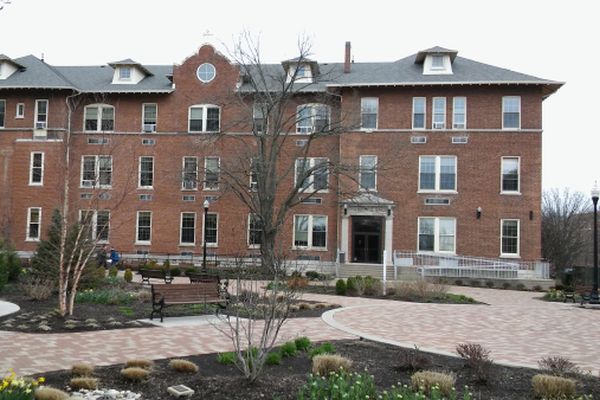A look into the future of Chaminade Hall
Pictured is Chaminade Hall. Photo courtesy the University of Dayton via its website.
Anel Solares | Contributing Writer
Few buildings on the University of Dayton campus can boast the activity that once took place in Chaminade Hall. In its heyday, it flaunted a cafeteria bustling with students, a growing library, several study spaces, pool tables, bowling alleys and top floor apartments. Now the only thing that remains is its name, as it stands mainly empty and unused.
Can it be reinvented?
Named after founder of the Society of Mary, Father Chaminade, the 120-year-old building sits in the middle of campus as a marker of UD history. Built in 1904, it housed things such as the Central Library in 1916, a student cafeteria in 1947, and a “Skylight Lounge” in 1957.
It held educational classes until 2014 when the School of Education and Health Sciences moved to what is now Fitz Hall. Failing to meet safety standards, the building closed that same year.
Today, the building is used for storing things such as COVID-19 supplies, as it’s unfit for any student or faculty activity. Part of the reason it closed was its absence of handicapped accessible bathrooms and the stairwell’s lack of doors that proved to be a fire hazard.
Many students today see the building as merely abandoned, and when asked if they knew anything about the building, answers varied.
“What even is Chaminade Hall? I’ve never step foot in there,” said senior KinsLeigh Jones.
“I know it’s one of the oldest buildings,” noted senior Giselle Franco.
“It looks pretty empty to me,” said junior Noah Garrick.
Aimed at saving the once historic building, the Chaminade Hall Vision Committee was formed in 2018. Two meetings were held before COVID-19 halted the committee’s work. Committee co-chairs Rick Krysiak and the Rev. James Fitz are now reviving the committee with the go ahead from President Spina in fall 2023.
Building upon the old committee’s work, the team converges at strategic and tactical meetings with the goal of finding a way to innovate the space.
Krysiak, vice president of Facilities Management and Planning, described in an interview the items the team is evaluating. Things like the size, shape, and footprint, including the loading dock behind Kennedy Union, are all being considered.
One possibility that’s been discussed is demolishing and rebuilding the building from scratch. This could mean adding two more stories to make it six floors, and from the committee’s research, widening its footprint to make it a total of 120,000 square feet.
What would it be used for? As Krysiak and Fitz have often said that keeping everything “student-centric” is a must. Up on the list of possible ideas is a 24/7 one-stop shop for all student services, which would be led by the Blue Sky Initiative. More meeting rooms and study spaces would also be included, similar to those in Kennedy Union.
Whether the building is renovated or demolished, one decision remains clear, the name of the building stays the same. Committee members who surveyed Marianist folks on campus found that while there was no nostalgia for the building itself, there was an attachment to the name.
Fitz, in an interview with this reporter, recalls the Blessed Chaminade statue standing outside Kennedy Union and says that while students may not know the history of the building, “I’m sure they know who it is named after.”
One of the biggest challenges the committee faces is meeting the needs of everyone. “Things have changed so much since the first committee was formed,” said Krysiak, “we really want it to be pedestrian friendly for students.” The committee hopes to complete and present its investigative report to President Spina in June 2024.
For more coverage, clink the link to check out our previous coverage of Chaminade Hall from 2019.

